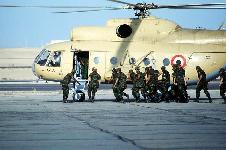

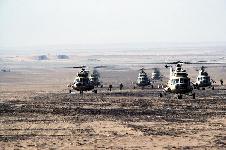
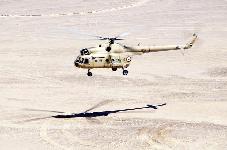
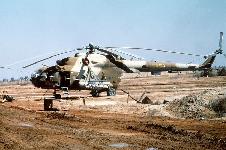
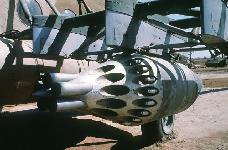

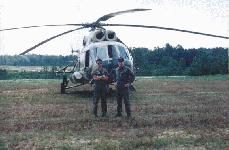
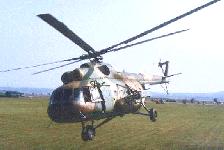

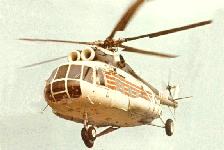

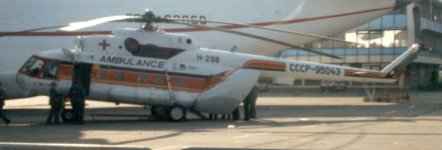
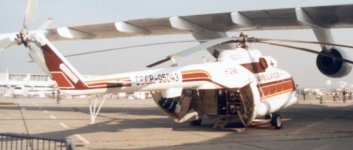

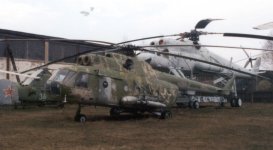

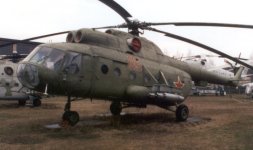
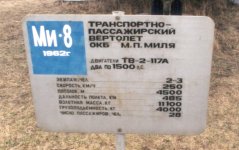




The large, five-blade main rotor is mounted over the engine at the body midsection, while a weapon-carrying platform is mounted at the lower body midsection. External stores are mounted on weapons racks on each side of the fuselage. The HIP C has four external hardpoints; the HIP E, HIP H, have six; other variants have none. Not all available munitions are employed at one time, mission dictates weapon configuration. Twin turboshaft engines are mounted on top of the fuselage with two round air intakes just above the cockpit and rounded exhaust ports aft. The Mi-8 is capable of single-engine flight in the event of loss of power by one engine (depending on aircraft mission weight) because of an engine load sharing system. If one engine fails, the other engine�s output is automatically increased to allow continued flight. The fuselage consists of a long, bus-like body with a rounded nose and glassed-in cockpit. Interior seats are removable for cargo carrying. The rear clamshell doors open, an internal winch facilitates loading of heavy freight. Floor has tiedown rings throughout. The aircraft carries a rescue hoist capable to 150 kg, and a cargo sling system capable to 3,000 kg. Two fuel pods are offset and mounted low on the body, which features an upswept rear section and tricycle landing gear. The tail boom tapers to the small, swept-back, and tapered fin with rotor on top right or left, with small flats mounted forward of the fin.
The first Mi-8 flew in January of 1960, and by 1985, more than 1500 Mi-8 were built. Mil Moscow helicopter plant joint stock company is the major designer and producer of military transport, civil transport, heavy-lift,multi-role helicopters. Mil is associated with the Rostov and Kazan production enterprises. Kazan is the oldest helicopter manufacturing plant in Russia and makes Mi-8 and Mi-17 helicopters. the Mi-8 was exported to Czechoslovakia, Algeria, East Germany, Hungary, Bolivia, Poland, Bulgaria, Yugoslavia, Finland, and Ethiopia.
Comparison | ||
| Variant | Mi-8 | Mi-17 Hip H |
| Engine | 2 TV2-117, 1482 hp each | 2 TV3-117VM 1900 hp each |
| Weight | 11100-12000 kg | 13000 kg |
| Maximum speed | 230-250 km/h | 250 km/h |
| Cruising speed | 225 km/h | 220 - 240 km/h |
| Service Ceiling | 4500 m | 6000 m |
Specifications | |
| Country of Origin | Russia |
| Builder | Mil |
| Date of Introduction | 1967 |
| Role | Armed assault-transport |
| Similar Aircraft | Puma, Mi-2 Hoplite, Super Frelon |
| Blades |
Main rotor: 5 Tail rotor: 3 |
| Rotor diameter |
Main Rotor : 21.3 meters [70 ft] Tail Rotor : 3.9 meters |
| Length |
Length (rotors turning): 25.2 m Length (fuselage): 18.2m [61 ft] |
| Height | 18 ft 6 in ( 5.65 m) |
| Width | 2.5 m |
| Cargo Compartment |
Floor Length: 5.3 m Width: 2.3 m Height: 1.8 m |
| Weight |
Maximum Gross: 12,000 kg Normal Takeoff: 11,100 kg Empty: 6,990 kg |
| Engine | 2 TV2-117, 1482 hp each |
| Maximum speed | 230-250 km/h |
| Cruising speed | 122 kts (140 mph; 225 km/h) |
| Range |
Maximum Load: 350 km Normal Load: 460 km With Aux Fuel: 950 km |
| Fuel |
Internal: 445 liters Internal Aux Tank: 915 liters ea. External Fuel Tank: 745 liters in port tank, 680 liters in starboard tank |
| Service Ceiling | Service: 4,500 meters Hover (out of ground effect): 800 meters Hover (in ground effect): 1,900 meters |
| Vertical Climb Rate | 9 m/s |
| Standard Payload |
|
| Armament |
|
| Survivability/Countermeasures |
|
| AVIONICS | The Mi-8 is equipped with instruments and avionics allowing operation in day, night, and instrument meteorological conditions. |
| Crew | 3 (2x pilots, 1x flight engineer) |
| Cost |
$900,000 (1991 used) $3,200,000 (new) |
| User Countries | At least 54 countries -- Armenia, Azerbaijan, Afghanistan, Algeria, Angola, Belarus, Bulgaria, Cambodia, CIS, Croatia, Cuba, Czech Republic, Egypt, Germany, Guyana, Hungary, Iran, Iraq, Madagascar, Mongolia, Mozambique, Nicaragua, North Yemen, People�s Republic of China, Slovakia, SouthYemen, Sudan, Syria, Ukraine, Vietnam, Yugoslavia, Zambia |



















